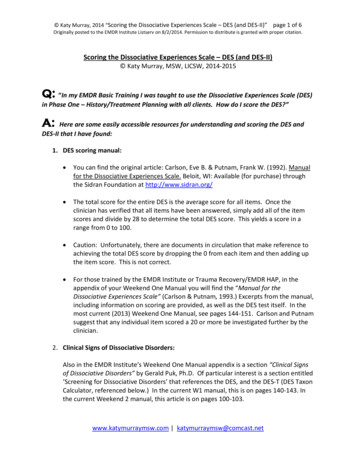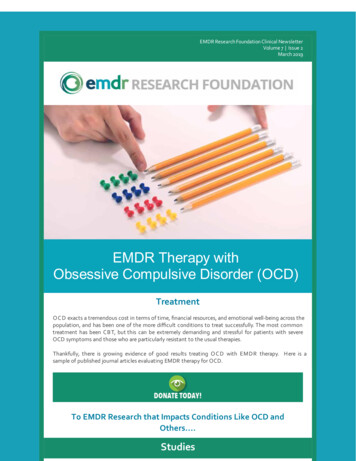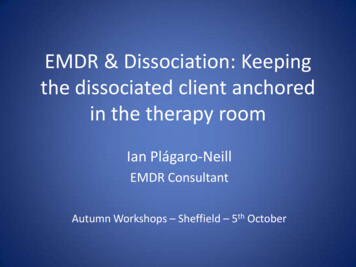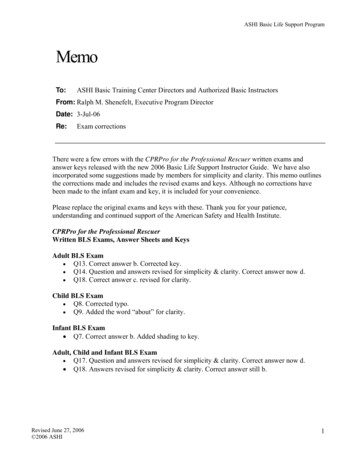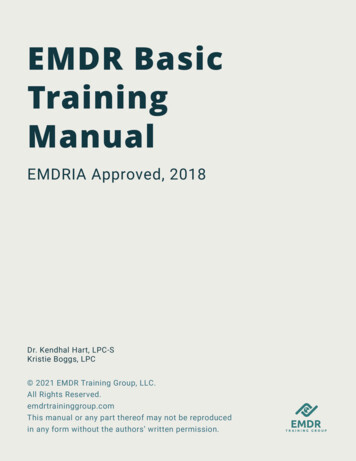
Transcription
EMDR BasicTrainingManualEMDRIA Approved, 2018Dr. Kendhal Hart, LPC-SKristie Boggs, LPC 2021 EMDR Training Group, LLC.All Rights Reserved.emdrtraininggroup.comThis manual or any part thereof may not be reproducedin any form without the authors’ written permission.
Table of ContentsCourse Requirements and ObjectivesVocabulary TermsHistory and OverviewEMDR Related ResearchUnderstanding EMDRModel, Methodology, and MechanismAdaptive Information Processing ModelMemory NetworksThree-Pronged ApproachEight Phases of EMDR TreatmentPhase 1: History Taking, Case Conceptualization, and Treatment PlanningTreatment PlanningMemory Selection and OrderingPhase 2: Client PreparationResourcing ScriptsPhase 3: AssessmentNegative and Positive Cognition ListPhase 4: DesensitizationChallenges in ProcessingFeeder MemoriesBlocking BeliefsCognitive InterweavesPhase 5: InstallationPhase 6: Body ScanPhase 7: ClosurePhase 8: RevaluationThree-Pronged Approach: Present TriggersThree-Pronged Approach: Future TemplateAdvanced MethodologyEMDR Protocol for Recent Critical IncidentsEMDR CommunityDissociative Experiences 4546474948505355562
Course Requirements and ObjectivesRequired Reading Shapiro, F. Eye Movement Desensitization and Reprocessing (EMDR) Therapy,Third Edition: Basic Principles, Protocols, and Procedures. (2018). New York: TheGuilford Press. (To be purchased separately) Go With That Magazine Fall 2020, Volume 25, Issue 3; EMDR and Racial Trauma(Available on our Learner Portal) Guidelines for Virtual EMDR Therapy (Available on our Learner Portal)Supplemental MaterialTrainees can find access to a current list of EMDR related research citations includingneurobiology research on their EMDR Training Group Learning Management Platformand the EMDRIA website EMDRIA.org.AttendanceThis training course is approved by The EMDR International Association (EMDRIA) andmeets requirements for EMDR Basic Training. EMDRIA requires total attendance, asoutlined below, to receive the certificate of completion. Instructional: 20 hours Supervised Practicum: 20 hours occurring in the form of small group practice. Consultation: 10 hours occurring between part one and part two of BasicTraining.EMDR Training Group is responsible for maintaining records of EMDR Basic Trainingrosters for a minimum of 5 years. The trainee is required to attend all 40 Instructionaland Supervised Practicum training hours. EMDR Training Group will not provide partialcredit for part one or part two of EMDR Basic Training; Participants must complete eachpart in its entirety in consecutive training days. The responsibility lies on the trainee tosign in and out on the daily roster provided as proof of attendance, and EMDR TrainingGroup does not assume responsibility if the Trainee fails to do so.EMDR Training Group integrates the 10 hours of group consultation into the price ofEMDR Basic Training in the form of five prescheduled, 2-hour group consultationsprovided by an EMDRIA Approved Consultant (AC) or Consultant in Training (CIT)associated with EMDR Training Group. Participants will register for these consultationgroups during part one of EMDR Basic Training. A trainee may schedule individualconsultation time(s) for an additional fee.3
According to EMDRIA, “The EMDRIA Approved Basic EMDR Training Provider (EMDRTraining Group) may designate which AC’s or CIT’s may provide the Consultation hoursto their trainees.” Should the trainee elect to obtain consultation hours outside of EMDRTraining Group, they will be responsible for completing a ‘consultation completion form’to be returned to EMDR Training Group before being awarded the certificate ofcompletion.Timely Completion RequirementsEMDRIA requires that trainees complete EMDR Basic Training, including all instructional,practicum, and consultation hours within 12 months of starting the virtual training toreceive a certificate of completion. EMDRIA requires that trainees attending an in-personEMDR Basic Training complete the entire course, including all instructional, practicum,and consultation hours within 24 months of starting the virtual training to receive acertificate of completion.Learning ObjectivesPart 1 Conceptualize clients from an EMDR perspectiveDescribe an essential premise of the Adaptive Information Processing (AIP) modelList the components of memoryName the 8 phases of EMDR therapyIdentify the prongs of the Three-Pronged Protocol of EMDR therapyDescribe criteria of client readiness for EMDRIdentify the purpose of the Assessment Phase of EMDR therapyDescribe strategies for assisting a client in staying within the window of toleranceDescribe how to close a session with an incomplete target memoryDescribe how to resume reprocessing following an incomplete target memoryDescribe when you would apply the Future TemplatePart 2: Distinguish between a client’s presenting problems and underlying issues Describe strategies to treat complex trauma with EMDR Describe client factors that indicate the need for additional stabilization and resourcing Distinguish between a recent traumatic experience and developmental trauma Describe a process to select and prioritize target memories appropriate for EMDRtreatment Describe how to offer a cognitive interweave when the client’s reprocessing is blocked Identify various types of cognitive interweaves Describe clinical symptoms that may indicate the presence of dissociation during asession Describe strategies for working with dissociative responses during reprocessing4
Vocabulary TermsAbreaction- Dysfunctional information is stimulated and experienced at a high level ofdisturbance, often displayed with intense emotions.Adaptive Information Processing Model (AIP)- The distinct information processingmodel represents the cornerstone of the EMDR approach to psychotherapy and guidesclinical practice.Affect Scan- A procedure using a current situation and body sensations to identify aTouchstone Memory.Bilateral Stimulation (BLS)- Eye movement, tapping, or alternating auditory stimulus isused as dual attention stimuli (external focus) as the client simultaneously focuses onsome aspect of the internal experience.Blocking Belief- Negative beliefs that are blocking progress in reprocessing.Channels of Associations- Events, thoughts, emotions, etc., within the targeted memorynetwork that spontaneously arise during reprocessing of the identified target(Touchtone Memory or node)Cognitive Interweave- A strategy that developed to jump-start blocked processingduring challenging sessions with more disturbed clients.Dissociative Experience Scale (DES)- A self-administered questionnaire measuringdissociative symptoms.Dual Attention Stimulation (DAS)- The experience of simultaneously attending to bothinternal (thoughts, emotions, sensations) and external (eye movements, tapping,sounds) stimuli.Negative Cognition (NC)- Negative Belief of self associated with inadequatelyprocessed, maladaptive stored negative experiencePositive Cognition (PC)- A positive self-belief is more adaptive than the negative beliefbeing targeted in EMDR.Set- 25 or more round trip passes of eye movements or other forms of bilateralstimulation (taps, tones) generally used for most clients during processing. Slower &shorter sets of 6-8 are used only during the Preparation Phase for establishing a Calmor Safe Place.5
Subjective Units of Disturbance Scale ( SUDS)- A scale measuring the level of distressassociated with a memory where 0 is no disturbance or neutral and 10 is the highestdisturbance or distress one can imagine.Target- A term used for the incident focused upon reprocessing within the agreed-upontreatment plan.TICES- Trigger, Image, Negative Cognition, Emotion, and (body) SensationsThree-Pronged Protocol- The three-pronged protocol consists of past events, presenttriggers, and future templates. These are components of the EMDR approach topsychotherapy that ensure comprehensive EMDR treatment effects.Touchstone Memory/Event- The earliest memory or experience a client can identifyrepresents the formation of the maladaptive stored memory network.Validity of Cognitions Scale (VOC)- The VOC measures how valid or accurate thepositive belief (PC) feels as one focuses on the target memory where 1 feels completelyfalse, and 7 feels completely true.6
History and OverviewUnderstanding TraumaIndividuals experience trauma from a variety of sources. The individual's perception ofthe event impacts the level of trauma. Trauma can be: Single incident Complex trauma- multiple incidents throughout a lifetime, often involvingrelational traumas Neglect- the absence of emotional, physical, psychological needs met inchildhood. Physical abuse Sexual abuse Emotional abuse Verbal abuseNeurobiology of TraumaTrauma alters the way the brain functions. Traumatic stress is associated withincreased cortisol and norepinephrine responses to subsequent stressors. Theamygdala often displays increased activity in response to stimuli that trigger a fearresponse. The hippocampus is also usually smaller in those who have experiencedtrauma due to elevated stress hormones making it difficult for the brain to identifydanger. Volume loss is also found in the ventromedial prefrontal cortex, making itchallenging to control reactions and behavior. Thalamus: Receives sensory input including visual, olfactory, sounds, and bodysensations Relays this information to various brain parts. Amygdala: Responsible for the emotional content of memories Acts as a warning system for the brain and body by scanning theenvironment for potential danger Relays this information to the hippocampus Hippocampus: Long-term memory for facts It helps the brain place memories within the context of other lifeexperiences (memory consolidation) Links sensory components of memory Prefrontal Cortex: Controls thoughts and actions. Brain Stem: This is often referred to as the “Reptilian Brain” and is involved withactivating defensive mechanisms and stress reactions. Defense mechanismsinclude the startle response and fight, flight, freeze, and appease responses.7
Origin of EMDRReference: Chapter 1 (Shapiro, 2018)Eye Movement Desensitization and Reprocessing (EMDR) was developed in 1987 byFrancine Shapiro after a chance observation that rapidly moving her eyes back in andforth alleviated distressing thoughts. Shapiro further explored this idea by testing it outon others with non-pathological complaints. Through this practice and successfuloutcomes, she developed a standard protocol.In 1989, Shapiro conducted a controlled pilot study that found “subjects suffering fromPTSD symptomology indicated that the procedure was highly beneficial fordesensitization, cognitive restructuring and elimination of pronounced intrusionsstemming from the traumatic event.” Since this initial study, a wide variety of clinicalresearch, including randomized controlled studies, has found EMDR effective andlargely applicable to various symptoms and disorders (Shapiro, 1989).This research and clinical studies have aided in developing additional protocols,manualized resources, and specific treatment guidelines.EMD was switched to EMDR in 1990 when Shapiro changed her orientation from abehavioral desensitization model to the more integrative Adaptive InformationProcessing (AIP) model. “The effect of EMDR therapy is not desensitization in and ofitself but includes the multifaceted impact of reprocessing all aspects of negative,maladaptive information to adaptive, healthy, useful resolution (e.g., change of belief,elicitation of insight, increase in positive effects, change in physical sensation, andbehavior)” (Shapiro, 2018).8
Current EMDR Therapy Related ResearchProvided below is a sample of current EMDR therapy-related research. A completebibliography is available on EMDRIA’s website and our Learning Management System.Meta-Analysis “Research indicates that CBT and EMDR therapy are superior to all othertreatments” (Bisson et al., 2013). “EMDR is equivalent to exposure and other cognitive-behavioral treatments. Oneshould note that exposure therapy uses one to two hours of daily homework andEMDR uses none” (Davidson & Parker, 2001).Randomized Clinical Trials “Twelve sessions of EMDR eliminated post-traumatic stress disorder in 77.7% ofthe multiply traumatized combat veterans studied. There was 100% retention inthe EMDR condition. Clients maintained effects at follow-up. This is the onlyrandomized study to provide a full course of treatment with combat veterans”(Carlson et al., 1998). “Thirty-three 6-16-year-old children with a DSM-IV diagnosis of PTSD wererandomly assigned to eight weekly EMDR sessions or the WLC group. EMDR wasfound to be an effective treatment in children with PTSD from various sourcesand who were suffering from a variety of co-morbid conditions” (Ahmad et al.,2007).Long Term Effect of EMDR EMDR treatment resulted in lower scores (fewer clinical symptoms) on all fouroutcome measures at the three-month follow-up, compared to those in theroutine treatment condition. The EMDR group also improved on all standardizedmeasures at 18 months follow-up (Edmond & Rubin, 2004, Journal of ChildSexual Abuse) (Edmond et al., 1999). Employees who had experienced “person-under-train accident or had beenassaulted at work were recruited.” Six sessions of EMDR resulted in remission ofPTSD in 67% compared to 11% in the waitlist control. Significant effects weredocumented in the Global Assessment of Function (GAF) and HamiltonDepression (HAM-D) score (Hogberg, 2007).o Follow-up: Outcome is stable in a 35-month follow-up (Hogberg, 2008).9
Treatment Guideline Studies Department of Veterans Affairs and Department of Defense (2010) “EMDR wasone of four therapies given the highest level of evidence and recommended fortreatment of PTSD.” The Substance Abuse and Mental Health Services Administration (SAMHSA) isan agency of the US Department of Health and Human Services (HHS) (2011)“This national registry (NREPP) cites EMDR as an evidence-based practice for thetreatment of PTSD, anxiety, and depression symptoms. Their review of theevidence also indicated that EMDR leads to an improvement in mental healthfunctioning.” World Health Organization (2013) “Trauma-focused CBT and EMDR are the onlypsychotherapies recommended for children, adolescents and adults with PTSD. American Psychiatric Association (2004) “EMDR was given the same status asCBT as an effective treatment for ameliorating symptoms of both acute andchronic PTSD.”Adaptive Information Processing (AIP) Research “EMDR in the treatment of borderline personality disorder. 20 EMDR sessionsthat focused on reprocessing the memories seemingly at the foundation of thepathology, along with triggers and future templates resulted in completeremission of BPD, including symptoms of affect dysregulation ” (Brown &Shapiro, 2006). “Comparison of eye movement desensitization and reprocessing with citalopramin the treatment of obsessive-compulsive disorder. “There was a significantdifference between the mean Yale-Brown scores of the two groups aftertreatment and EMDR was more effective than citalopram in the improvement ofOCD signs” (Nazari et al., 2011). “Some effects of EMDR treatment with previously abused child molesters:Theoretical reviews and preliminary findings. “As predicted by the AdaptiveInformation Processing model, the EMDR treatment of the molesters’ childhoodvictimization resulted in a decrease in deviant arousal as measured by theplethysmograph, a decrease in sexual thoughts, and increased victim empathy.Effects maintained at one year follow up” (Ricci et al., 2006).Research on Eye Movements “EMDR-with eye movements led to a greater reduction in distress thanEMDR-without eye movements” (Schubert et al., 2011). “The effect size for the additive effect of eye movements in EMDR treatmentstudies was moderate and significant” (Lee & Cuijpers, 2013). “Eye movements reduce vividness and emotionality of distressing visual imagesabout feared future events” (Englehard et al., 2010).10
Hypothesized Mechanisms of Action and Neurobiological Aspects of EMDR TherapyGiven the infancy of neurobiology, the physiological foundations of all psychotherapiesare currently unknown, and therefore, all neurobiological models of psychotherapy arespeculative. Testing of hypotheses about EMDR’s neurological mechanisms awaits thedevelopment of advanced brain imaging techniques. Theories concerning EMDR’sneurobiological mechanisms are, at this time, purely speculative. As clinicians becomemore proficient, it is advised they seek out continuing education regarding theneurobiology of EMDR. There are several theories on the role of eye movements andbilateral stimulation, which clinicians can read more about via their learner portal or theEMDRIA website.11
Understanding EMDRThe goal of EMDR is to help clients adaptively process these dysfunctionally storedmemories or events.A dysfunctionally stored memory/event still has some of the images, thoughts,emotions, and body sensations that occurred at the time of the event.“Essentially, the childhood perspective is locked in place, and it causes theperson to perceive the present from a similar vantage point of defectiveness(e.g., I’m unlovable/not good enough), lack of safety, or lack of control. Cliniciansobserve this every day in their practices: clients “know” they shouldn’t be feelinghopeless or powerless or unlovable, but they do. They may slip into the intonationof childhood when speaking of earlier experiences. There is a split between whatthey want to do and what they can do; between the possibilities available andtheir ability to perceive and act upon them” (Shapiro, 2018).An adaptively processed event means that adequate learning has taken place and thememory exists with appropriate emotions. These memories are successful in guidingthe person in future thoughts and actions.EMDR is Desensitization AND Reprocessing. The goal of EMDR therapy is to reducesymptoms of anxiety through desensitization. It also helps the client reprocess thedysfunctionally stored memory resulting in the natural replacement of their currentnegative cognition with a positive one. Bilateral stimulation is only one component ofthe complex approach.EMDR utilizes a comprehensive approach to address specific memory components,including images, beliefs, emotions, bodily sensations, and increased insight.12
Model, Methodology, and MechanismThe Adaptive Information Processing model is the underlying explanatory model ofEMDR therapy. The AIP model guides treatment, history taking, case conceptualization,treatment planning, intervention, and predicts outcome. The methodology includes theeight-phase treatment procedure of the basic EMDR therapy protocol, plus safeguards,ethics, and validated modifications for specific clinical situations. The mechanismconsists of current hypotheses regarding how or why EMDR therapy works on theneurobiological level, plus recent research exploring mechanisms of action.ModelAdaptive Information Processing Model (AIP) The neurobiological information processing system is intrinsic, physical, andadaptive. This system is geared to integrate internal and external experiences. Memories are stored in associative memory networks and are the basis ofperception, attitude, and behavior. Experiences are translated into physically stored memories. Stored memory experiences are contributors to pathology and health.Memory Networks Trauma disrupts normal adaptive information processing, resulting inunprocessed information dysfunctionally held in memory networks. Trauma can include DSM 5 PTSD Criterion A events or the experience of neglector abuse that undermines an individual’s sense of self-worth, safety, ability toassume appropriate responsibility for self or others or limits one’s sense ofcontrol or choices. New experiences link into previously stored memories, which are the basis ofinterpretations, feelings, and behaviors. If high levels of disturbance accompany experiences, they may be stored in theimplicit/non-declarative memory system. These memory networks contain theperspectives, effects, and sensations of the disturbing event and are stored in away that does not allow them to connect with adaptive information networks. When similar experiences occur (internally or externally), they link into theunprocessed memory networks and the negative perspective, affect, orsensations arise. This expanding network reinforces the previous experiences. Adaptive (positive) information, resources, and memories are also stored inmemory networks.13
Direct processing of the unprocessed information facilitates linkage to theadaptive memory networks and transforms all aspects of the memory. Non-adaptive perceptions affect, and sensations are discarded As processing occurs, there is a posited shift from implicit/non-declarativememory to explicit/declarative memory and from episodic to semantic memorysystems (Stickgold, 2002). Memory processing causes an adaptive shift in all memory components,including the sense of time and age, symptoms, reactive behaviors, and sense ofself.Clinical ImplicationsThe AIP guides case conceptualization, treatment planning, intervention and predictstreatment outcome. Clinical complaints that are not organically based or caused by insufficientinformation are viewed as stemming from maladaptively stored and unprocessedinformation, which has been unable to link with more adaptive information. Earlier memories that are maladaptively stored increase vulnerability topathology, including anxiety, depression, PTSD, and physical symptoms of stress. These maladaptively stored memories may interfere with the healthydevelopment of an individual’s sense of self-worth, safety, ability to assumeappropriate responsibility for oneself or others or limit one’s sense of control orchoices. The information processing system and stored associative memories are theprimary focus of treatment. Procedures are geared to access and process dysfunctional memories andincorporate adaptive information. The intrinsic information processing system and the client’s own associativememory networks are the most effective and efficient means to achieve optimalclinical effects. Clinicians must access targeted memories as they are currently stored to makeappropriate associative connections throughout the relevant networks. Unimpeded processing allows the full range of associations to be madethroughout the targeted memory and the more extensive integrated networks. Interventions to assist blocked processing should mimic spontaneousprocessing. All interventions change the natural course of processing and potentially closesome associated pathways. Following any intervention, the target will be reassessed and fully processed inthe original form. Processing shifts all elements of memory to an adaptive resolution.14
Differentiating EMDR from Other Models of Therapy Cognitiveo Irrational thoughts are the basis of pathologyo Cognitions change through reframing, self-monitoring, and homeworkexercises. Behavioralo Cannot see within the “black box” (the brain)o Learned behavior changes through conditioning, exposure, modeling, etc. “Third wave” of CBTo Suffering is inevitableo Change is through acceptance, commitment, and Mindfulness exercises Psychodynamico Explores the impact of Family of Origin, Object relationso Change occurs through insight or “working through”o The goal is to make the subconscious conscious Family Therapyo Problems and solutions are interactionalo Exploration and evaluation of family dynamicso Change through education and role realignment Experientialo Facilitates client self-healingo Affect and body are centralApplicationsEMDR is effective with a variety of symptoms and diagnoses: PTSDAnxiety DisordersPhobiasPanic DisorderVictims of Crime and Violent AssaultsGriefDepressionEating DisordersChildrenChemical DependencyDissociative DisordersPerformance AnxietySomatoform Disorder including Body Dysmorphia and Chronic PainPersonality DisordersSome non-validated applications still need research.15
Three-Pronged ApproachRemember: Trauma negatively impacts the healthy development of an individual.Presenting problems are tied to memories and past events, which are maladaptivelystored.Prong 1: Past: Events that laid the groundwork for the client’s current distress. Connect current symptoms with past experiences Identify early life experiences that have laid a foundation for the client’s currentdysfunctional behaviors, response patterns, bothersome emotions, and negativebeliefs about themselves, others, and the world.o These early life experiences are potential targets for reprocessing.Prong 2: Present: Present experiences that are triggering them or causing distress What led the client to seek therapy?Prong 3: Future: Potential future experiences that may be triggering What future challenges might occur?16
Three-Pronged Approach: Prong 1Past EventsEMDR is a 3-pronged approach: past, present, and future. The 8-phases handle theprocessing of memory and reduce distress related to present triggers. The futuretemplate handles the processing of future concerns that may cause distress. A clinicianhas not completed EMDR on a targeted memory until they process past maladaptivememories, present triggers and complete a future template.MethodologyThe methodology includes the eight-phase treatment procedure of the basic EMDRtherapy protocol, plus safeguards, ethics, and validated modifications for specificclinical situations.8 Phases of EMDR Treatment:Phase 1:History TakingPhase 2:PreparationPhase 3:AssessmentPhase 4:DesensitizationPhase 5:InstallationPhase 6:Body ScanPhase 7:ClosurePhase 8:Reevaluation17
Phase 1: History Taking, Case Conceptualization, andTreatment PlanningPurpose of Phase 1 To identify appropriate client selection and readiness for EMDR.o Some clients may not be appropriate for EMDR To obtain a detailed history of the client. To identify potential treatment targets.History Taking Unique to EMDR“The clinician must assess the client’s readiness and ability to uncover and withstand theinformation in order to ascertain whether or not the client can be guided through thedisturbance that may emerge as the memory is treated.” (Shapiro, 2009)Some things to look for or work toward include:Level of rapport- client’s ability to experience and tolerate vulnerabilityAffect tolerance: ability to tolerate emotional disturbanceClient’s ability to emotionally regulateAssessing for overall stabilizationDrug and alcohol abuseLegal concernsMotivation for changeTimingMedication needsPhysical/medical concernso Epilepsyo Neurological impairmentso Eye Problems Therapy interfering behaviorso Secondary gaino Present-day stressors that may need to take precedence Maintaining dual attention Dissociative disorders or dissociationo See DES in Appendix D Window of ToleranceThe window of tolerance is used to describe the zone in which an individual canfunction most effectively. When individuals are within their window of tolerance, theycan readily receive, process, and integrate information and manage the demands of18
their life without much difficulty. When an individual experiences a high level of distress,they may leave their window of tolerance and experience hyperarousal or hypoarousal.When in a state of hyperarousal or hypoarousal, one is not able to process informationeffectively. The brain’s prefrontal cortex is offline, impacting one’s ability to reason andleading to emotional dysregulation. Each individual’s window of tolerance is different,and some clients may need help learning to widen their window so they may be able totolerate intense emotions without entering a hyperaroused or hypoaroused state. Hyperarousal is the fight or flight response and may present as high anxiety,racing thoughts, anger, feeling out of control, or overwhelmed. Hypoarousal: The freeze response and the person may present as spacy,zoned-out, numb, or frozen.Dual AttentionMaintaining dual attention is imperative for EMDR therapy. Dual attention involvessimultaneously attending to present stimuli (BLS) and past trauma. Dual attentiontriggers a physiological state that leads to information processing in the brain. Stimulithat can activate the information processing system include eye movements, tactiletaps, or auditory tones. If a client cannot maintain dual attention, EMDR will beineffective. Additionally, the inability to sustain dual attention can lead to a client gettingstuck in a high level of disturbance and worsening clinical symptoms. Dual attentionmight be conceptualized as maintaining “one foot in the past and one foot in thepresent.”Indications a client is not maintaining dual attention include: Distracted in session Unable to be present; worried about the future Difficulty transitioning out of the mildly distressing event while establishingSafe/Calm PlaceInterventions when a client is not maintaining dual attention: Pause and attempt to reorient the client to the present Ask them to identify things in the room using their five senses. Specifically focuson sight, smell and touch. Was it easy for the client to transition back to the present? Remind the client about the reality of the situation by using supportivestatements such aso “It’s over now.”o “It’s in the past.”o “You are here now with me, looking back on the experience.”19
Treatment PlanningThe therapist’s goal in treatment planning is to identify parallels between the client’spast experiences and present symptoms to isolate responses patterns.*As an EMDR trained therapist, clinicians should consistently be looking for a client’sunderlying negative cognitions about themselves, others, or the world.Assess and identify the client’s
EMDR Training Group integrates the 10 hours of gr oup consultation int o the price of EMDR Basic Training in the form of fiv e prescheduled, 2-hour gr oup consultations provided by an EMDRI A Approved Consultant (A C) or Consultant in Training (CIT) associated with EMDR Training Group. Par ticipants will r egister for these consultation

